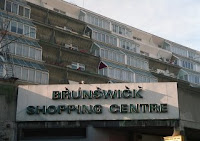
From Nothing to See Here, a lovely little piece about the Brunswick Centre in Bloomsbury:
"The Brunswick finally opened in 1972 but the flawed execution doomed it to membership of an inauspicious club of similar buildings which all shared a love of concrete, as well as the knack of being distinctly unpopular. Other offenders included the Trellick Tower in west London, the Bull Ring in Birmingham and the Tricorn Centre in Portsmouth. These ambitious structures were collectively labelled as Brutalist architecture, a style which became synonymous with failed social projects. Decline was often hastened by government reluctance to supply adequate funding during the recessions of the 70s and 80s. Over the years the public association between brutalism and decay became entrenched and the buildings became a prime focus for Prince Charles’ carbuncle obsession. Yet, although often flawed, the modernist utopian vision which underpins the schemes is emblematic of a post war vision to engineer a better world. That their design still provides us with a powerful sense of the future so far in the past, perhaps says much about our contemporary desire and ability to build a better tomorrow."
